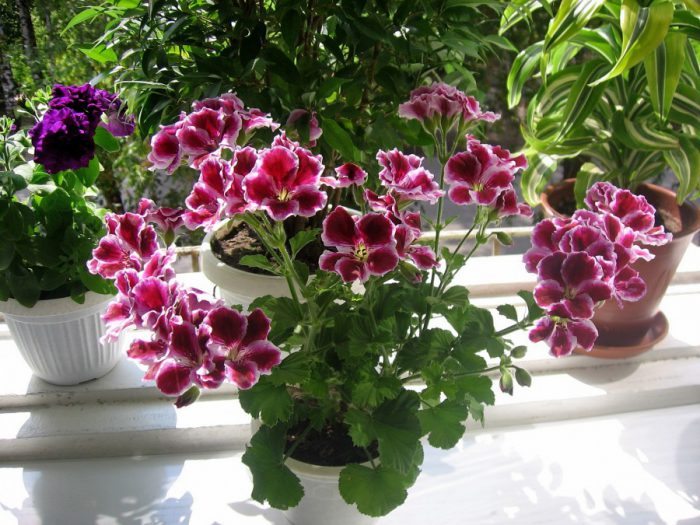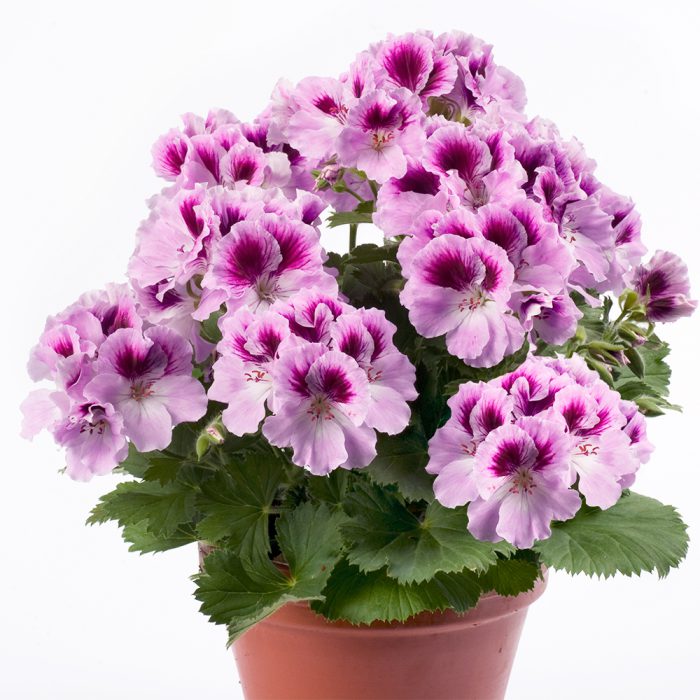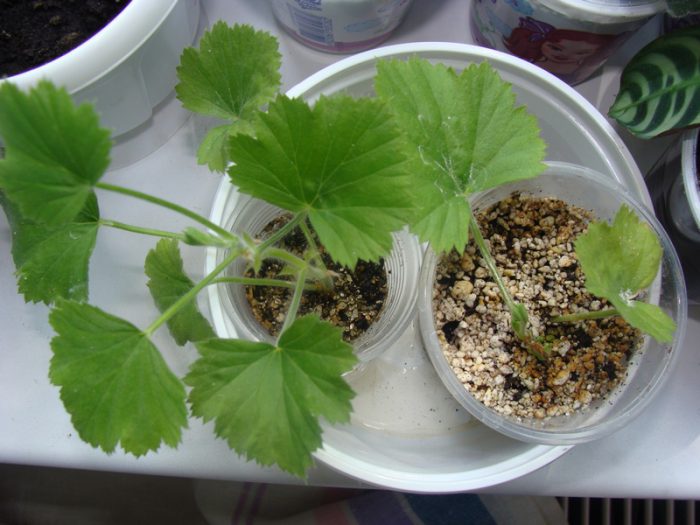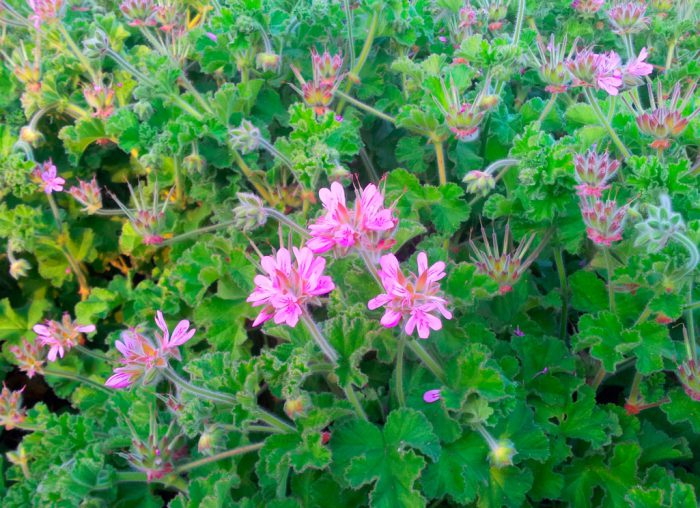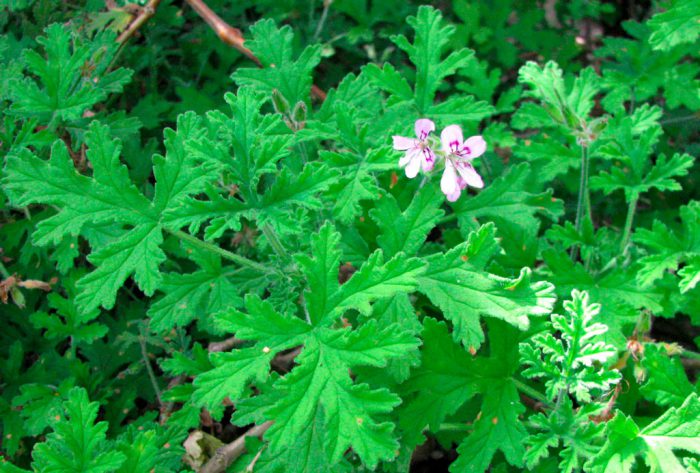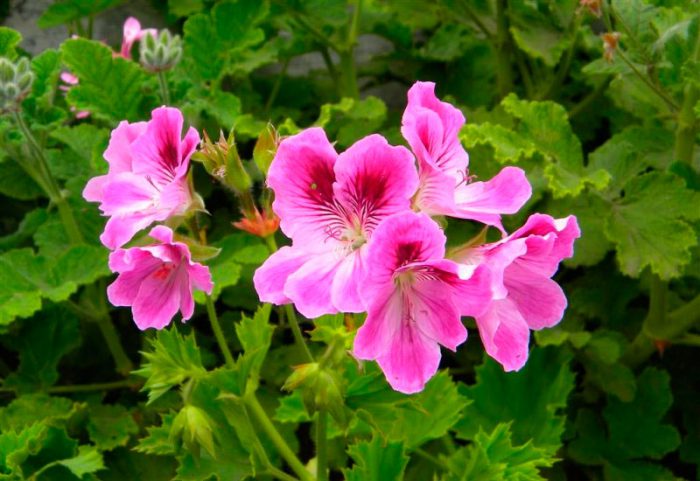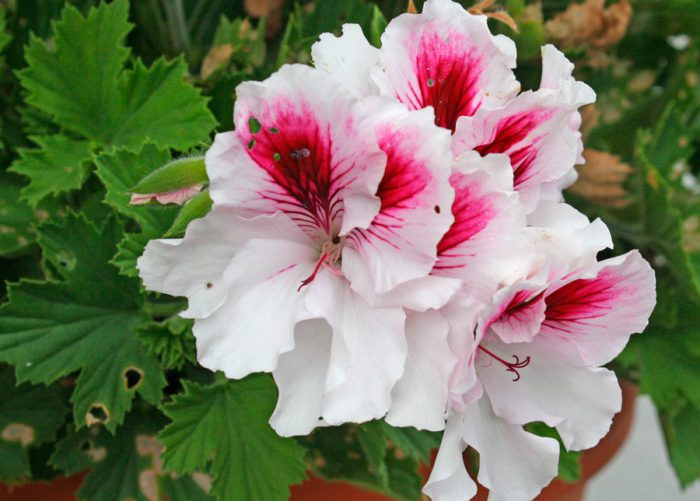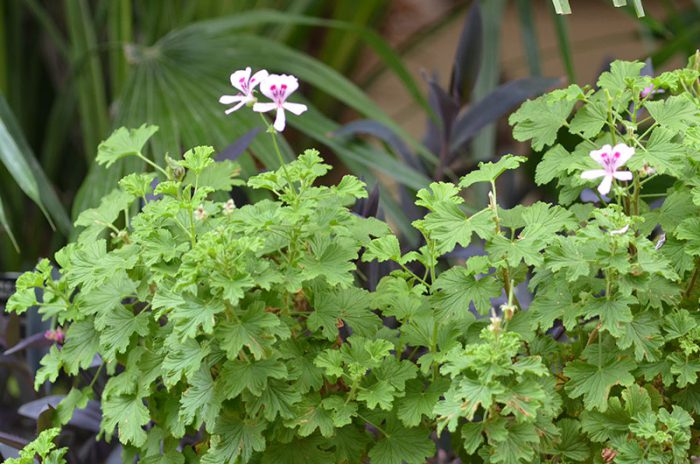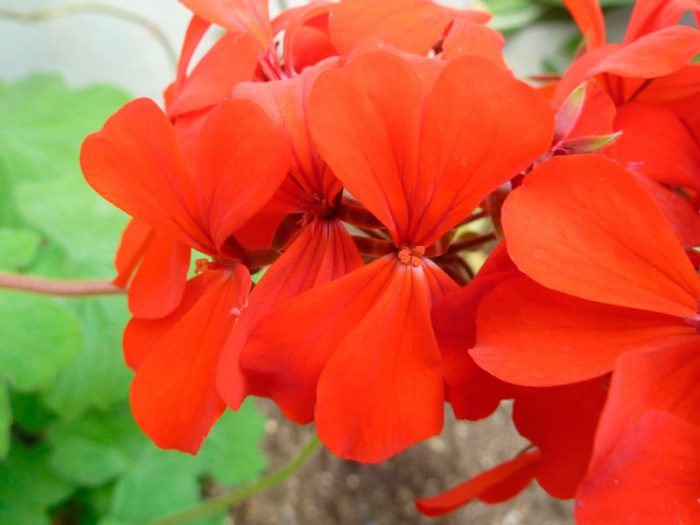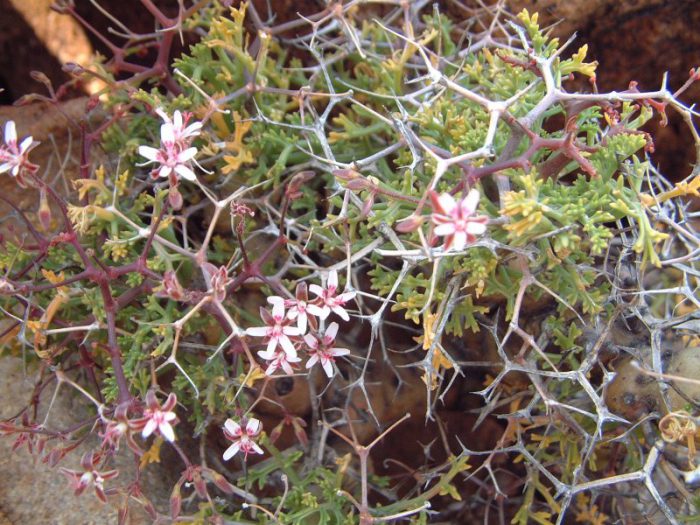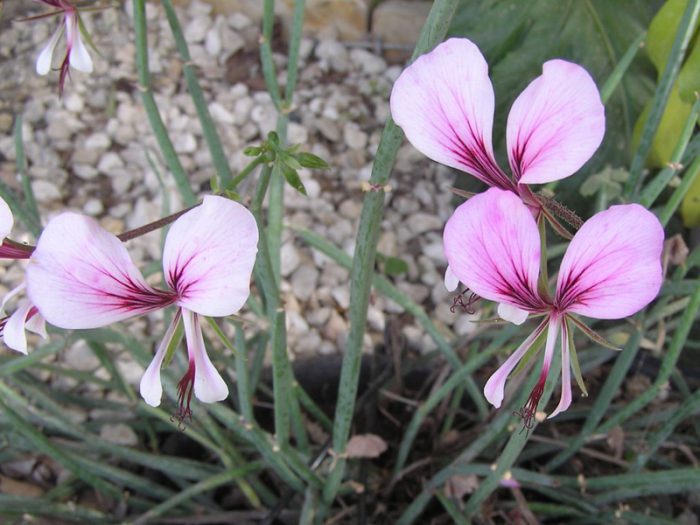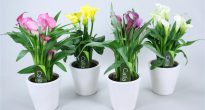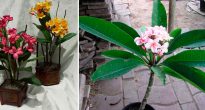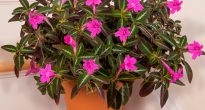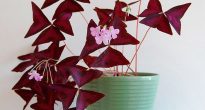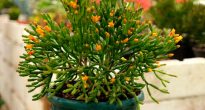Pelargonium (Pelargonium) is directly related to the geranium family. This genus unites about 350 species of various plants, which are herbaceous perennials, but there are shrubs and succulent plants.
Such a plant grown at home has one unusual property. So, its aroma can calm and relax some people, while others feel worse when inhaled. Only a few species are grown indoors, but the choice is quite rich.
Pelargonium has a rather spectacular appearance. However, this is not all. It contains substances that are used in medicine and perfumery. So, the essential oil obtained from this plant is used to create perfumes and soaps, and it is also used as part of means for cleaning the air from pathogenic bacteria and harmful impurities.
Content
- 1 Home care for pelargonium
- 2 Video review
- 3 Main types
- 3.1 Aromatic Pelargonium (Pelargonium graveolens)
- 3.2 Pelargonium capitatum (Pelargonium capitatum)
- 3.3 Fragrant Pelargonium (Pelargonium odoratissimum)
- 3.4 Pelargonium zonale
- 3.5 Pelargonium nodule (Pelargonium cucullatum)
- 3.6 Pelargonium grandiflorum (Pelargonium grandiflorum)
- 3.7 Curly Pelargonium (Pelargonium crispum)
- 3.8 Pelargonium staining (Pelargonium inquinans)
- 3.9 Pelargonium fluffy (Pelargonium crithmifolium)
- 3.10 Pelargonium pink (Pelargonium radens)
- 3.11 Pelargonium angulosum
- 3.12 Pelargonium tetragonum
- 3.13 Pelargonium corymbose (Pelargonium peltatum)
Home care for pelargonium
Illumination
This plant is quite light-requiring and needs direct sunlight for normal growth. Pelargonium is recommended to be placed near south-facing windows. However, it grows and develops quite normally near the northern orientation window, but it is important that the daylight hours are long enough. Otherwise, the stems are pulled out. In summer, if possible, this plant is transferred to fresh air (to the balcony or to the street). The room in which pelargonium is located must be regularly ventilated, as it reacts negatively to stagnant air.
Temperature regime
In the summer, the plant needs a temperature of 20 to 25 degrees. In winter, it is required to rearrange it in a rather cool place to ensure normal flowering. In winter, the temperature in the room should not exceed 14 degrees.
How to water
In the summer, watering is recommended after 3 or 4 days after the top layer of the substrate dries out. You can check the condition of the soil by gently deepening your finger a couple of centimeters.In winter, it is necessary to water a little less, but at the same time you need to make sure that the earthen lump does not dry out completely. If, during a cool winter, a liquid stagnates in the soil, this can provoke the appearance of root rot, which often leads to the death of the entire bush.
Foliage spraying
It grows and develops normally at low air humidity. There is no need to moisten foliage with a spray bottle, but it can be done during the hot summer months.
Fertilizer
The plant is fed 1 or 2 times, while the interval between fertilizing is 2 weeks. Fertilizers are first applied to the soil when 2 months have passed after transplanting. Top dressing is needed to improve flowering, therefore, fertilizers containing a large amount of phosphorus are chosen. It is not recommended to feed organic fertilizers, because pelargonium absorbs them rather poorly.
Pruning
Pruning should be done once a year, leaving stems with 2–4 nodes. As a result, the bush will be more lush, and the flowering will be more abundant. It is necessary to remove yellowed or dried leaves in a timely manner. It is impossible to tear off the sheets, since in this case the torn edges can rot. To remove such leaves, it is recommended to use a very sharp knife, and the cut should be treated with chopped charcoal. After trimming the leaf, the warp of the petiole should remain on the branch.
Transplant features
Young plants are transplanted once a year, and adults are transplanted as needed, for example, when the roots no longer fit in the pot. Don't forget to make a good drainage layer at the bottom of the container. To prepare a suitable soil mixture with your own hands, you will need turf, humus and leafy soil, sand and peat, which should be taken in equal parts.
Reproduction methods
Such a plant can be propagated by cuttings and seeds.
When grown from seeds, plants very often lose varietal characteristics, and this should be borne in mind when choosing a propagation method. The low container should be filled with a potting mix made of sand, peat and turf, which should be taken in equal parts. Seeds are sown in it. In order for the seedlings to appear as soon as possible, the container is placed in a place where the temperature is constantly kept at 22 degrees. In such favorable conditions, seedlings appear half a month after sowing. Seedlings are transplanted into separate small pots. And after the plants grow out of them, they are transplanted into pots, the diameter of which is 9 centimeters. The first time the plant should bloom a little over a year after sowing, but this is only with proper care.
Apical cuttings are excellent for reproduction. Their cutting and rooting is carried out in the last winter or summer weeks. The cut should be made at an angle slightly below the node, while at least 3 leaves should remain on the handle, and it is better if there are 3-5 pieces of them. Leave the cutting outdoors for a few hours to dry. Before planting it, you need to process the cut points, using crushed charcoal and a root growth stimulator for this. Prepared cuttings should be planted around the perimeter in a container filled with an earth mixture (sand, turf and peat in equal proportions). To increase the splendor of the bush, it is recommended to pinch the stalk. The container is placed in a well-lit place, but the light should be diffused. It is necessary to systematically moisten the soil from the sprayer. Full rooting will occur 15–20 days after planting. Fortified plants are seated in separate containers. A small pot for planting is chosen, since otherwise the flowering will be scarce. The plant will bloom 5–7 months after complete rooting.
Virulence
Some types of pelargonium are poisonous. If you do not know for sure whether a species growing in your home is poisonous, then you need to be careful when working with such a plant. So, be sure to wash your hands well after working with it.
Diseases and pests
Can settle on pelargonium aphid or whitefly.
In most cases, plant problems are associated with improper care:
- Lack of flowering - Pelargonium is sick, it has harmful insects, or it hibernated in a warm, well-lit room.
- The lower leaves wither, turn yellow and rot - abundant watering. Reduce watering and gently remove affected leaves.
- Blisters appear on the surface of the foliage - water often stagnates in the soil.
- The lower leaves turn yellow and their edges dry out - poor watering.
- The base of the stem is blackened - root rot (Black leg).
- Gray rot - due to too much watering.
Video review
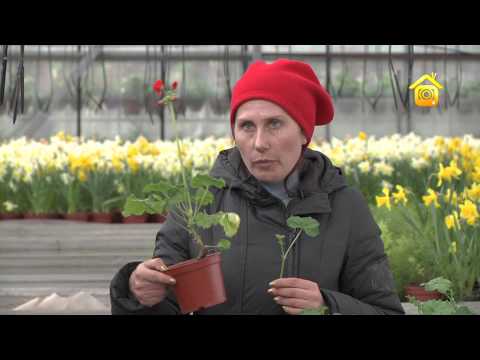

Watch this video on YouTube
Main types
Aromatic Pelargonium (Pelargonium graveolens)
This evergreen, pubescent shrub is highly branched and can reach a height of 100 centimeters. The green pubescent leaves are divided into 5-7 lobes and have a very pleasant aroma. Umbrella-shaped inflorescences consist of a large number of pinkish flowers. Blooms throughout the summer.
Pelargonium capitatum (Pelargonium capitatum)
This plant is an evergreen shrub, the height of which does not exceed 50 centimeters. There is pubescence on the surface of the stems and leaves. Stems are straight. Green, as if crumpled, leaves are divided into 3-5 parts. The inflorescence is in the shape of an umbrella. There are many sessile flowers, colored in light pink with a purple tint. Flowering is observed from mid to late summer. Possesses fragrant foliage.
Fragrant Pelargonium (Pelargonium odoratissimum)
The foliage of this shrub does not fall off, and its stems are rather short. Rounded-heart-shaped leaves can be up to 5 centimeters wide. Their edges are slightly ragged, and there are soft short hairs on the surface. The foliage is very aromatic and the scent is quite pleasant. Inflorescences in the form of umbrellas. Whitish-pink flowers are collected in 8-10 pieces.
Pelargonium zonale
These shrubs reach a height of 100 centimeters. There is pubescence on the surface of their fleshy stems. As a rule, the leaf plate is solid, but sometimes it is slightly lobed. The foliage is green and has a brownish border around the edge. The flowers are colored red and are collected in multi-flowered inflorescences. Flowering lasts from late spring to early autumn.
Pelargonium nodule (Pelargonium cucullatum)
The homeland of such an evergreen shrub is South Africa. There is pubescence on its surface. Long-petiolate leaves are colored green. The umbrella-shaped inflorescence consists of many purple-red flowers. The plant blooms from the end of the summer period to the beginning of the autumn. There are varieties with terry foliage.
Pelargonium grandiflorum (Pelargonium grandiflorum)
It is a highly branching evergreen shrub that can reach a height of 100 centimeters. The kidney-rounded leaves can be either dissected or lobed. They can also be smooth or pubescent. No more than 3 flowers are formed on the peduncle, and they are painted white, and the existing veins are reddish. The diameter of the flowers is 3–4 centimeters. This shrub blooms from mid-spring to early summer.
Curly Pelargonium (Pelargonium crispum)
Such an evergreen shrub reaches a height of 50 centimeters and is highly branching. Dense heart-shaped leaves growing in 2 rows have serrated, ragged-wavy edges. Flowering is observed from the middle to the very end of the summer period. On short pedicels 2-3 flowers grow. It has thick leaves.
Pelargonium staining (Pelargonium inquinans)
Such a shrub, which is evergreen, can reach a height of 1.5 meters. Has fleshy stems. Rounded buds are dark green. The inflorescences are in the shape of an umbrella. Short pedicels. The flowers are red. Flowering time depends on care, and can be observed during the summer, autumn, winter, or late spring.
Pelargonium fluffy (Pelargonium crithmifolium)
This deciduous plant is a succulent and has thick, creeping stems. The leaf plate is divided into pinnate lobes, the length of which is 8 centimeters. They have a bluish color and can be either pubescent or without pubescence. Inflorescences are presented in the shape of an umbrella. The length of the pedicels is from 15 to 20 millimeters. Snow-white flowers grow in 5 or 6 pieces, and in the throat they have small reddish spots.
Pelargonium pink (Pelargonium radens)
The evergreen highly branching shrub is pubescent and can reach a height of 50 centimeters. There is bilateral pubescence on the leaf plate, while there are hard hairs on the front side, and soft hairs on the seamy side. The leaves are fairly deeply divided and have curved edges. They are fragrant and have a pleasant aroma. The pubescent peduncle is presented in the shape of an umbrella. On the peduncle, several pieces of pink flowers with dark veins grow.
Pelargonium angulosum
This plant can reach a height of 100 centimeters. The foliage is similar in shape to oak leaves, but the lobes are not straight, but wavy. They are short petiolate. The inflorescence is in the shape of an umbrella, and it consists of a large number of flowers, usually colored deep red. If you take care of the plant correctly, then it will bloom from the end of the summer to the middle of the fall.
Pelargonium tetragonum
This deciduous shrub can reach a height of 0.6–0.7 meters. Tetrahedral straight shoots are pale green, sometimes with a grayish tinge. On the surface of the heart-shaped leaflets, there are sparse hairs. Their width is usually 5 centimeters. The edges of the leaf blade are brownish red. The flowers have 5 pinkish or creamy petals, with 2 smaller ones on the bottom and 3 larger ones on the top.
Pelargonium corymbose (Pelargonium peltatum)
This evergreen shrub is ampelous. The stems are glabrous or pubescent. The green, shiny, fleshy leaves have a thyroid shape, smooth edges and are divided into 5 lobes. On their surface, there may or may not be pubescence. The flowers are collected in several pieces in an umbrella-shaped inflorescence. They are pink, white or red in color. Flowering lasts from mid-spring to late summer.


